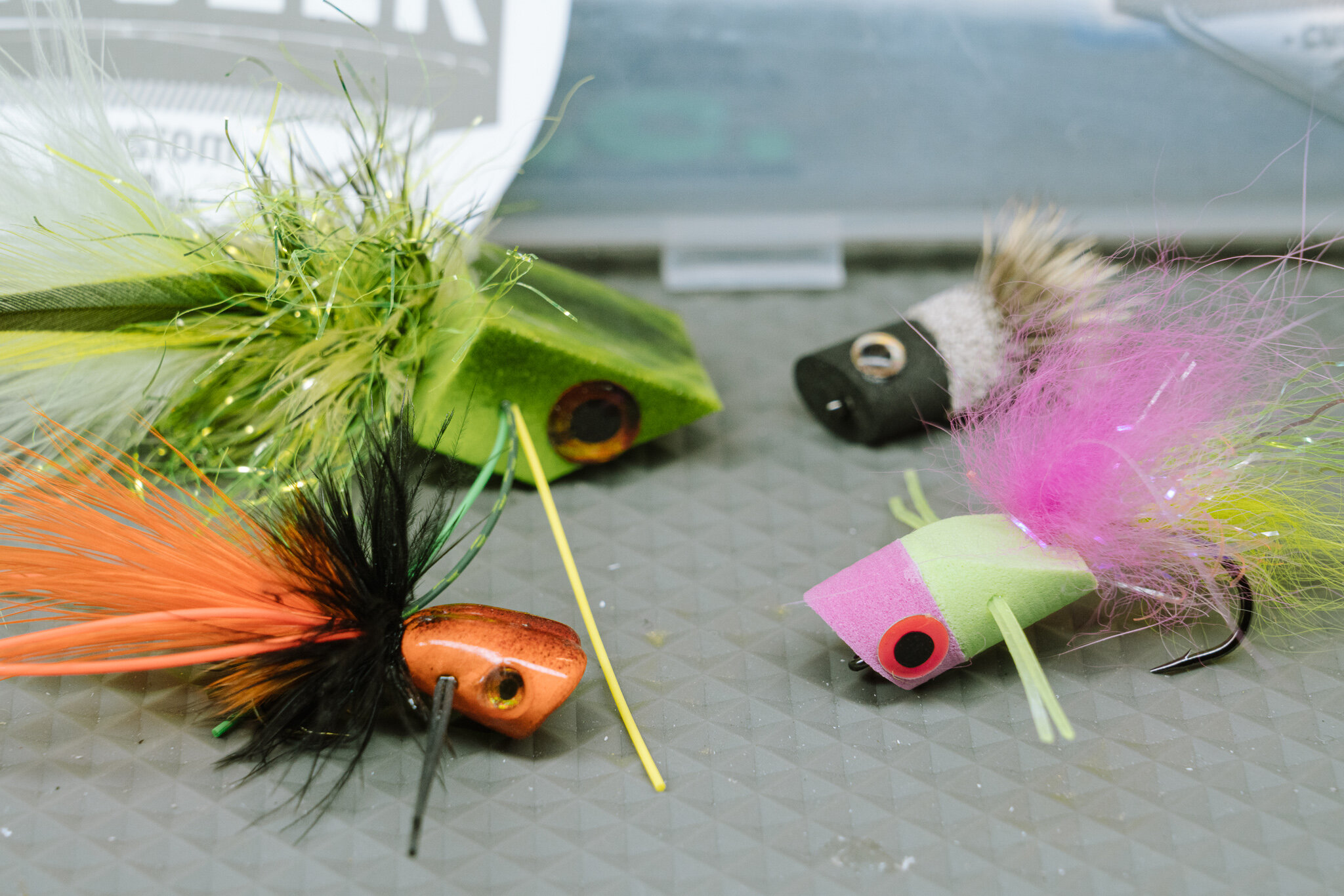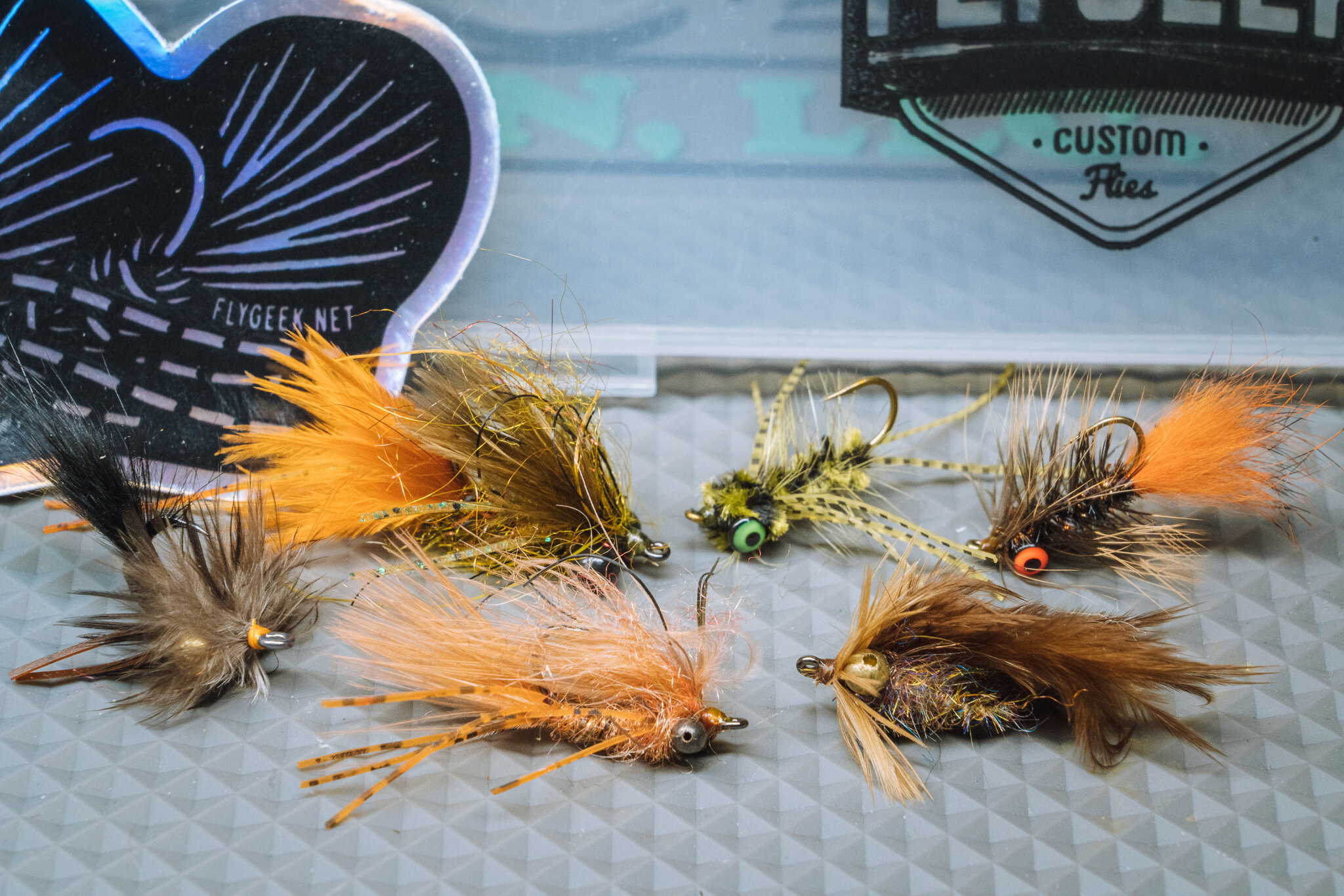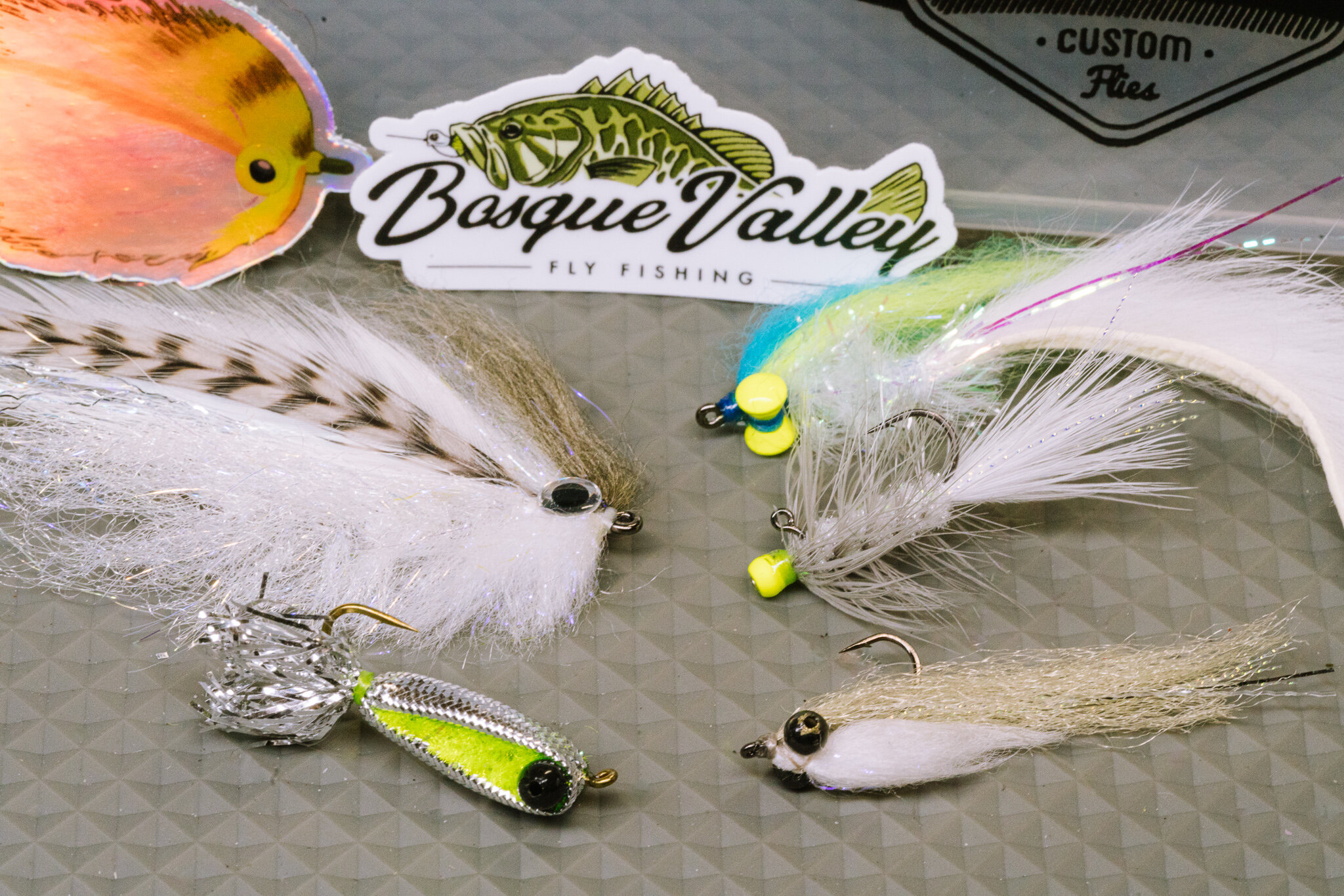April 2021 - Poppers!
Although things have definitely been a little slower this year to wake up, April usually finds topwater bass fishing in full swing here in Texas. I did a super-special run of poppers for this box and am really happy with how they turned out.
For poppers, I like to vary my retrieve speed and cadence until I get a reaction. Some days they’ll want them worked faster with shorter strips, other days is big strips with long pauses. Definitely experiment with the length of time you let them sit as well - sometimes I’ll cast out and let them sit until well after the ripples from them landing have disappeared.
Two of these patterns are airbrushed and specially coated for durability, which also changes the popping sound they emit, as does the shape of the body. You should have four different options to experiment with where you fish! I chose not to do weedguards on these as I find that I only need them in very specific situations. Have fun with these - I did some experimenting with them myself a few weeks ago and had a blast on some big farm pond bluegill!
Patterns (Left to right, top to bottom:)
Holschlag Blockhead variation featuring Paul Beels’s Brain Dead Poppers, 1/0
Double Barrel Popper, in the style of the old Accardo Poppers from years back, 6
Llanolope, special batch with different colored heads, 4. Special thanks to Jim Gray for doing these.
Krebb’s Popper / Papa Joe’s Popper mashup, 2. Should work great for saltwater as well!
March 2021 - Spring Carp
First off, my apologies for getting this up so late - it’s been a very busy spring kickoff for me. The idea for March was focusing on carp flies for the spring for the Texas Hill Country. Lucky for you, bass and panfish are also after the same forage this time of year, which is good news for most of us, as carp are easily one of the most difficult fish to pursue ‘round these parts.
Carp fishing is about finding the right fish. Unlike most other fish species we target here, they’re not typically opportunistic feeders. The key here is finding a fish that is actively feeding. You can usually determine this by finding a solo fish that is kicking up a mudcloud (best case) or just slowly cruising near the bottom. Fish will definitely feed in groups but you run the risk of spooking one or all of them and blowing your shot. Cast well in front of the fish, drag your fly into the path it’s taking, and let it sit still until the fish is very close. Then, I usually give the fly some micro-strips to move it just a little. Feel for a slight “tick” on your line on just when it goes tight, and set the hook with a short strip-set. Try not to raise your rod on the hook set as it can pull the fly out of the carp’s mouth.
That’s carp fishing in a nutshell. For flies, you’re all about natural colors on the bottom with very little flash. Think crawfish, dragon/damselfly nymphs, etc. Here’s what I put together with those in mind, keep in mind the colors you may have received will vary:
Front Row, left: Scarpion (Black) (special thanks to Chase Smith of Fish Chase Flies for tying these,) Bennett’s Carp-It Bomb (Rust,) and Zimmerman’s Backstabber (Brown)
Back Row, left: Bennett’s “Craw”p-It Bomb (Olive/Orange,) Rainy’s Carp Tease (Black/Olive,) Rainy’s Mad Chicken Leech (Brown/Orange)
February 2021 - White Bass / Striper Box
Well. February was quite the month, wasn’t it? Not sure how it was for all of you, but we had quite the crisis here in Austin. I had friends burning furniture in their fireplaces to stay warm after many days without power and temps that got down to 5F! Pretty wild.
The extent of damage on our fisheries of the extended brutal cold has yet to be realized. Looking at reports on the coast, especially the lower coast, they’re estimated very substantial fish kills. Closer to home, I’ve heard of a few spots with dead fish (mostly Rios) due to the temps, but we’re kind of in “want and see” mode right now.
Temps have swung back to above normal with highs in the 70s and 80s. Redbuds are in bloom, so you know what that means. Our water situation is still fairly low, so we’ll see what this year’s white bass run holds. Pat Vanek with Bosque Valley Fly Fishing was kind enough to tie up some of his Ghost Minnows (bottom right) for this month’s box. It’s one of my absolute favorite white bass flies.
Other flies for this month - Galloup’s Belly Bumper Bunker (top left,) Cypert Minnow (bottom left,) Lunch Money / Zonker variation (top right,) Balanced Bugger (middle right). All of these should be fished on a sink-tip or full-sinking line when targeting white bass in our rivers. They tend to hug the bottom and don’t often move up in the currently to nab food above them.
January 2021 - Winter Texas Coast Box
While most people outside of Texas look upon our definition of winter with some eye rolling we’ve had a fairly legitimate one this year so far, complete with some pretty cold temps and a dumping of snow all the way down to San Antonio or so.
In general, winter time is for targetting our stocked trout, but don’t forget about our coastal areas as well, which can also fish great in the wintertime, provided you don’t pick a day after a big northern cold front to go battle the wind.
This fly selection was put together with the Texas Coast in mind but contains options for redfish, trout and of course bass for you strictly freshwater-only folks.
Four patterns total this month, and there’s a myriad of color variations, so I included a few of each here so you could see. Special thanks to Steven at Sight Cast for tying up some his Redfish Cracklins this month. I’m happy to stick a few in my box as well!
Strongarm Merkin, Blue Crab (Top Left,) Texas Gurgler, Watermelon Chartreuse & Blurple (Bottom Left,) Sight Cast Redfish Cracklin’, Blue Crab & Olive (Top Right,) Bendback Half & Half, Baitfish & Backcountry (Bottom Right).
December 2020 - Texas Tailwater Assortment
Winter time in Texas means trout season, whether it be stocked fish at your local pond or the larger, typically a bit more wary fish that find their way into the tailwater section of the Guadalupe River below Canyon Dam.
Trout are a bit of a mystery to a lot of folks here who are more used to tossing flies for bass and sunfish. Trout eat fairly small insects naturally, and the long stocked fish are in their new waters, the more they gravitate towards these same insects. For us fisherman, this usually means small nymph rigs with a larger or brighter, attractor fly on top and a more natural dropper fly on bottom, all under a strike indicator and drifted downstream as naturally as possible.
Flies here, starting top left, are the Jigged Mop (attractor,) Flyphoria Guadalupe Trout Killer (attractor.) 2nd row: Mini Clown Egg (attractor,) Jigged Frenchie (either,) Dorsey’s Mercury Black Beauty (dropper,) Sexy Walt’s Worm (either.) Last row: Blood Midge (dropper,) RS2 (dropper,) Jigged Lightning Bug (either) and Dorsey’s Top Secret Midge (dropper.)
To reiterate from last year’s assortment, I recommend fishing these in a double nymph rig under an indicator with the flies being 10-16” apart. I typically will fish a size small Airlock indicator with 4x or 5x tippet to my first fly, and two size 6 split shot about 10” above 7” above the top fly. From the bend of the attractor top fly (the larger or brighter flies work best here,) I’ll tie on 12-16” of 5x tippet to my dropper fly (more natural lightly weighted fly.) From there, you’ll want to adjust your indicator to the proper depth of the target water you’re fishing. These flies do best when near the bottom. Feel free to also fish the GTKs as a small streamer, and maybe try trailing one of the other flies behind it!.
November 2020 - The Baitfish Box
Another repeat of last year’s theme, I did a second version of the Baitfish Box for this November. Five flies total, a few different color variations of each. These should cover you in waters big and small, fresh or salt, and everywhere in-between.
First, for the large fly, I did a Hollow-Tied Bucktail Deceiver on an Ahrex Salt Series Minnow 2/0. This is definitely a big guy meant for lakes, rivers and the coast where you might be after some larger quarry. Below that on the left is a twist on the ever-popular Murdich Minnow. I incorporated some of Gunnar Brammer’s philosophies with his Slow Jig Clouser with this and sandwiched them in-between the classic Murdich style.
One the right is your standard Lunch and Brunch Moneys. I did some brighter Lunch Moneys in Pink and Chartreuse, and a few different variations of Brunch Moneys with some Pastels or Olive and Black, as shown here. Finally, I rounded things off with a Jigged Craft Fur Clouser in Chartreuse or Minnow Gray. Hope you guys dig these!
October 2020 - The Fall Streamer Box 2
Wow - it’s been a year, right? I’m so appreciative of everyone keeping me absolutely bursting at the seems with fly orders this year. It was all I could do to try and keep up. I’m going to try to get back in the habit of keeping this updated again. Since about March or so, I’ve started doing variations of colors and sizes of each pattern, so you won’t necessarily have the exact options pictured. As always, if you ever have questions about what you receive, feel free to give me a shout via email or the contact link above!
Just like the inaugural Lunch Box, I focused on some proven fall streamers for this month with a few variations on classic and proven patterns.
The two single-hook patterns are Ted Kraimer’s Autumn Offender (left) and John Barr’s Slump Buster (right.) Both are similar, zonker-style streamers and I added my own spin on them as I typically do. I kept them just slightly weighted as our local water levels are a bit on the low side, but you can always add a sinking line or polyleader (or even some split shot) to help get them down as you need two.
The two articulated patterns are a variation on Russ Madden’s Circus Peanut (jigged and mini-sized, top left) and my own take on the ever-popular Double Deceiver template (top right.) I can’t wait to see what you guys catch on these! Bigger baitfish flies are key in the late fall, and I love jigging crawfish-style patterns around structure, especially timber on the Lower Colorado here below Austin. Good luck out there!
February 2020 - The White Bass / Striper Box
Late February typically brings mixed weather for our area, and this year has been no different. Even with that being the case, the Redbuds have started to show, which means the annual migration of white bass (and stripers, and even crappie in some areas) has begun.
White bass, along with striped bass and their hybrids, are true bass, unlike our “other” Largemouth and Guadalupe Bass, which are part of the sunfish family. Each year, depending on water temps and flow, the white bass venture out of the lakes and into the rivers, both chasing the shad and also locating suitable riffles for spawning. They’re a local favorite quarry with a fly rod, and this selection of flies should help in your quest to find a few.
I typically fish these on a very short leader with a sinking or sink-tip fly line, on a 4-6 wt. rod, gravitating more towards the higher-end where there’s more stripers to be found, usually up around the Waco area. Natural and chartreuse baitfish patterns are typically the name of the game, and don’t be surprised to find the local spots full of people during the run, especially on the weekends. It can often turn into a bit of a zoo. I’ll usually forego some of the more popular spots like the Steps above Granger Lake, opting to walk in another place and check there and have it more to myself.
I fish these as close to the bottom as I can get them, usually swinging them through the current with short, quick strips. Larger flies are for the stripers, so I’ll typically throw the middle or bottom patterns in the picture above first.
Craft Fur Baitfish 1/0 Chartreuse/White, Bulkhead Baitfish 3/0 Olive/White
Brunch Money 8 Shad, Whitlock’s Sheepshad 2
SF Blend Sparkle Clouser 2 Chartreuse/White, Johnson’s Brushy Creek Streamer 10 Olive/White






